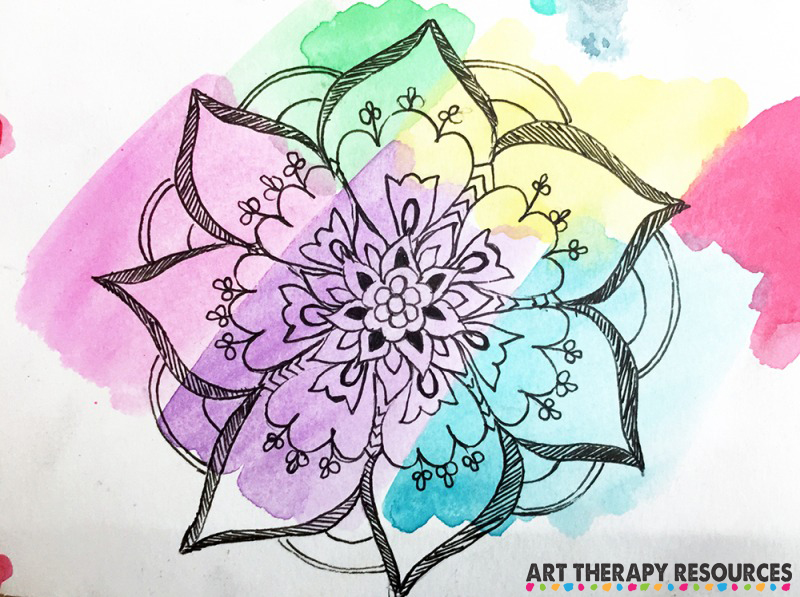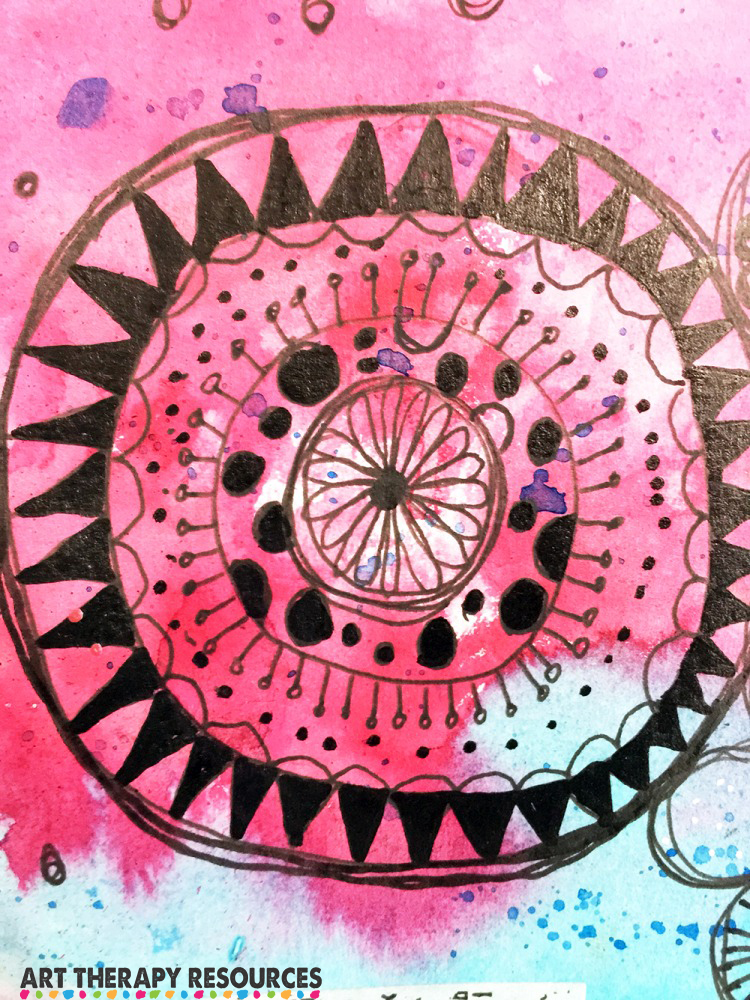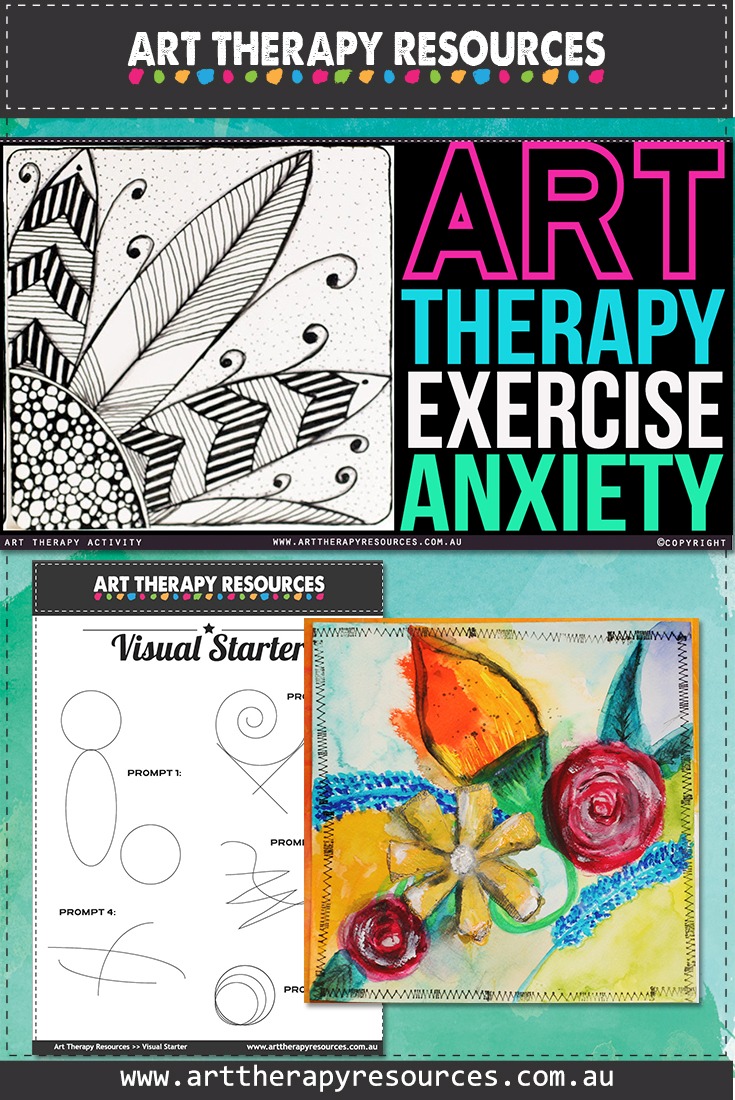THIS POST INCLUDES:
1. What is Anxiety
2. Benefits of Art Therapy for Anxiety
3. Art Therapy Exercises for Anxiety
3. Free Download of Art Therapy Exercises
WHAT IS ANXIETY
Anxiety refers to thought and behavioural issues that result from excessive fear and anxiety. Fear is best described as an emotional response to a real or perceived threat, whereas anxiety focuses on the anticipation of a future threat. Anxiety may often be described by words such as stress, worry or nervousness.
Every day we live under some level of pressure where anxiety can sometimes help us to prepare for difficult or stressful times. We can often regulate the feeling of anxiety through relaxation techniques, hobbies, exercise, entertainment or talking with someone.
In a best case scenario, the feelings of anxiety are shortlived and we return to our normal day to day routines without any major disruption. However, in some cases, these levels of anxiety are more intense and prolonged and as a result, the effect on our lives becomes more disruptive and abnormal.
Anxiety is classified as a disorder once the symptoms of anxiety become chronic and disrupt our ability to function in our daily lives.
Anxiety is not always easily defined in terms of behavioural experiences. One person may initiate coping mechanisms that are internalised through poor concentration, poor memory, and avoidance behaviours. Alternatively, another person may exhibit anxiety externally through physical symptoms such as shortness of breath, sweaty hands, and physical weakness.
Anxiety is a general term, however, the DSM-5 details anxiety in various subtypes:
ANXIETY DISORDERS (subtypes)
- Agoraphobia
- Anxiety Disorder Due to Another Medical Condition
- Generalized Anxiety Disorder
- Other Specified Anxiety Disorder
- Panic Disorder
- Selective Mutism
- Separation Anxiety Disorder
- Social Anxiety Disorder (Social Phobia)
- Specific Phobia
- Substance/Medication-Induced Anxiety Disorder
HELPFUL CONTACTS:
BENEFITS OF ART THERAPY FOR ANXIETY
Art therapy helps facilitate cognitive disruption by moving attention away from rumination. This redirection of attention away from worrying then helps to regulate the nervous system.
Art therapy allows us to express ourselves visually and rely less on verbal expression. Verbal expression can be a difficult task if a client is catastrophising. The feelings of being overwhelmed can make verbal expression difficult which then negatively impacts the clients perception of self-managing feelings and thoughts.
Art Therapy can benefit clients by initially diffusing a stressful environment in the therapy setting. Techniques will help the client feel calm and able to focus on the task at hand. Once this anxiety is defused, the client is then more open to process thoughts, emotions and assess behaviour.
Art therapy can also assist anxiety by improving self esteem, resolving problems, expressing feelings, problem solving and goal setting which aids in working towards improved thinking patterns.
Below is a summary of some of the benefits of art therapy for helping with anxiety:
- Calms the nervous system
- Acts as a distraction
- Interrupts rumination
- Encourages focus on one thing
- Increases self-esteem from the act of creating something
- Reduces over-stimulation from external sources
- Provides tactile stimulation
- Venting, releasing stress
- Useful when verbal expression is limited
- Encourages “play”
- Art activities can be undertaken outside of therapy when situations arise
ART THERAPY EXERCISES FOR ANXIETY
1. MIND BODY CONNECTION
The mind and body are closely connected and can influence each other in a feedback loop whereby the mind creates feelings of tension in the body, and heightened feelings in the body leads to overthinking in the mind.
In this exercise, ask your client to use a pencil or pen to draw the outline of a body. Before your client draws the body outline, ask them to take a minute to reflect on physical feelings in their own body in this moment and consider if their body is feeling any tension, pain or discomfort in any areas.
Incorporate the knowledge of these physical feelings when drawing the body outline.

———————————————————————————————————-
2. 1 MINUTE BRAIN DUMP
Ask your client to draw a large circle to represent a thought bubble. Inside the thought bubble, ask your client to draw or write words to brain dump all of the issues they are currently feeling anxious about. Do this exercise in a minute. Using a shortened time frame will help your client “dump” their worries and reduce the possibility of rationalising or minimizing their feelings of anxiety.

———————————————————————————————————-
3. MIND MAP ANXIETY
Explain to your client the concept of mind mapping. Ask your client to then create a mind map focusing on one current pervasive issue that is causing anxiety at this time. As part of the mind map, label the components that contribute to the anxiety. Some examples of labels to consider in the mind map:
Some examples of labels to consider in the mind map:
- What triggers the initial situation
- Emotional feelings
- Physical feelings
- Negative thoughts
- Interpersonal interactions
- Calming techniques
Each label may be represented multiple times.
———————————————————————————————————-
4. GRATITUDE JOURNALING
Ask your client to use journaling as a method of exploring gratitude within their life. This exercise can be done generally by exploring all facets of your client’s life or it can be done with a specific focus on a situation that is causing your client anxiety. For eg. If a situation at work is causing anxiety, the gratitude journaling could focus on things to be grateful about in their employment outside of the stressful situation that exists, ie helpful colleagues, good pay, interesting work etc.
———————————————————————————————————-
5. VISUAL STARTER
Reduce your client’s anxiety about creating art by providing a visual starter to help loosen them up. Use the download provided as a stimulus to create an artwork. A number of prompts are provided in the download. You can use each prompt to create various individual artworks or use all of the prompts for a larger artwork.
———————————————————————————————————-
6. WORRY CLOUD
Ask your client to draw a cloud where all of their worries can be placed inside. Your client can then transform their drawing to show their worry cloud being blown away by the wind. As clouds also reshape, your client can use this metaphor as a process of reshaping their own worries.
———————————————————————————————————-
7. COMFORT CASTLE
Ask your client to create their own castle of comfort. The castle can have many levels that contain many of the personal comforts your client has. Your client can use this comfort castle as a process of implementing coping strategies to deal with anxious feelings that arise.
———————————————————————————————————-
8. MANDALA
Introduce your client to mandala drawing. This ancient art form helps with feelings of anxiety as they require focused attention to create the patterns. The repetition of patterns and rhythmic movements help to reduce heightened emotions.
Research suggests (Can Coloring Mandalas Reduce Anxiety?) that “structured coloring of a reasonably complex geometric pattern may induce a meditative state that benefits individuals suffering from anxiety.”
A replication study ( Can Coloring Mandalas Reduce Anxiety? A Replication Study ) also supports the hypothesis that colouring a mandala reduces anxiety.


———————————————————————————————————-
9. CREATE PATTERNS
Similiar to mandala’s, you can introduce your client to creating their own patterns. An artform called Zentangle has emerged in recent years which falls under this category of pattern drawing. Zentangles are miniature pieces of abstract patterns that are defined as “artistic meditation” through the process of focused attention in creating the patterns.
Watch this video for an example of creating patterns.
———————————————————————————————————-
10. AFFIRMATION CARD
Ask your client to create an affirmation card or series of cards that they can carry in their purse or wallet. At any time they feel anxious they can look at the affirmation card and reflect on the affirmation to help them deal with their anxious feelings.
Examples include:
- This too shall pass
- Breathe calmly
- I am calm
- I live in peace
- The future is good
- I am free
- I am not in danger, just uncomfortable
- This will become easier
- I have control over my thoughts
- STOP!
- Find gratitude for 3 things
FREE DOWNLOAD: Art Therapy Exercise
SIGN UP below to download the FREE pdf containing Visual Starter images to use in this Art Therapy Exercise.

BUILD YOUR ART THERAPY REFERENCE MATERIALS:
Pin this image to your Pinterest board.

SHARE KNOWLEDGE & PASS IT ON:
If you’ve enjoyed this post, please share it on Facebook, Twitter, Pinterest. Thank you!
